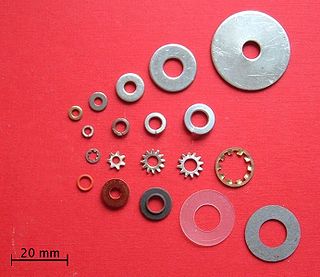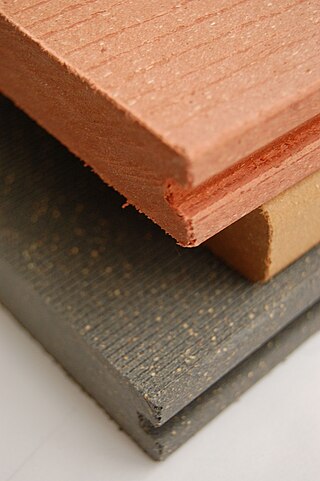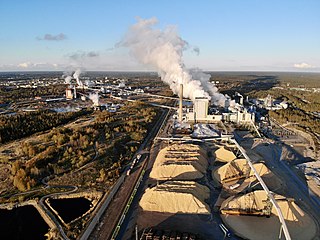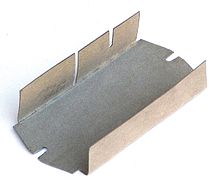
Pulp is a fibrous lignocellulosic material prepared by chemically, semi-chemically or mechanically producing cellulosic fibers from wood, fiber crops, waste paper, or rags. Mixed with water and other chemicals or plant-based additives, pulp is the major raw material used in papermaking and the industrial production of other paper products.

Medium-density fibreboard (MDF) is an engineered wood product made by breaking down hardwood or softwood residuals into wood fibre, often in a defibrator, combining it with wax and a resin binder, and forming it into panels by applying high temperature and pressure. MDF is generally denser than plywood. It is made up of separated fibre but can be used as a building material similar in application to plywood. It is stronger and denser than particle board.

Paperboard is a thick paper-based material. While there is no rigid differentiation between paper and paperboard, paperboard is generally thicker than paper and has certain superior attributes such as foldability and rigidity. According to ISO standards, paperboard is a paper with a grammage above 250 g/m2, but there are exceptions. Paperboard can be single- or multi-ply.
Wood fibres are usually cellulosic elements that are extracted from trees and used to make materials including paper.

A paper machine is an industrial machine which is used in the pulp and paper industry to create paper in large quantities at high speed. Modern paper-making machines are based on the principles of the Fourdrinier Machine, which uses a moving woven mesh to create a continuous paper web by filtering out the fibres held in a paper stock and producing a continuously moving wet mat of fibre. This is dried in the machine to produce a strong paper web.

Lamination is the technique/process of manufacturing a material in multiple layers, so that the composite material achieves improved strength, stability, sound insulation, appearance, or other properties from the use of the differing materials, such as plastic. A laminate is a layered object or material assembled using heat, pressure, welding, or adhesives. Various coating machines, machine presses and calendering equipment are used.

Glare is a fiber metal laminate (FML) composed of several very thin layers of metal interspersed with layers of S-2 glass-fiber pre-preg, bonded together with a matrix such as epoxy. The uni-directional pre-preg layers may be aligned in different directions to suit predicted stress conditions.

A washer is a thin plate with a hole that is normally used to distribute the load of a threaded fastener, such as a bolt or nut. Other uses are as a spacer, spring, wear pad, preload indicating device, locking device, and to reduce vibration.

Wood–plastic composites (WPCs) are composite materials made of wood fiber/wood flour and thermoplastic(s) such as polythene (PE), polypropylene (PP), polyvinyl chloride (PVC), or polylactic acid (PLA).

A pulp mill is a manufacturing facility that converts wood chips or other plant fiber sources into a thick fiber board which can be shipped to a paper mill for further processing. Pulp can be manufactured using mechanical, semi-chemical, or fully chemical methods. The finished product may be either bleached or non-bleached, depending on the customer requirements.

Tracing paper is paper made to have low opacity, allowing light to pass through. Its origins date back to at least the 1300s where it was used by artists of the Italian Renaissance. In the 1880s, tracing paper was produced en masse, used by architects, design engineers, and artists. Tracing paper was key in creating drawings that could be copied precisely using the diazo copy process. It then found many other uses. The original use for drawing and tracing was largely superseded by technologies that do not require diazo copying or manual copying of drawings.

Paper is a thin sheet material produced by mechanically or chemically processing cellulose fibres derived from wood, rags, grasses, or other vegetable sources in water, draining the water through a fine mesh leaving the fibre evenly distributed on the surface, followed by pressing and drying. Although paper was originally made in single sheets by hand, almost all is now made on large machines—some making reels 10 metres wide, running at 2,000 metres per minute and up to 600,000 tonnes a year. It is a versatile material with many uses, including printing, painting, graphics, signage, design, packaging, decorating, writing, and cleaning. It may also be used as filter paper, wallpaper, book endpaper, conservation paper, laminated worktops, toilet tissue, currency, and security paper, or in a number of industrial and construction processes.
Dissolving pulp, also called dissolving cellulose, is bleached wood pulp or cotton linters that has a high cellulose content. It has special properties including a high level of brightness and uniform molecular-weight distribution. This pulp is manufactured for uses that require a high chemical purity, and particularly low hemicellulose content, since the chemically similar hemicellulose can interfere with subsequent processes. Dissolving pulp is so named because it is not made into paper, but dissolved either in a solvent or by derivatization into a homogeneous solution, which makes it completely chemically accessible and removes any remaining fibrous structure. Once dissolved, it can be spun into textile fibers, or chemically reacted to produce derivatized celluloses, such cellulose triacetate, a plastic-like material formed into fibers or films, or cellulose ethers such as methyl cellulose, used as a thickener.

Electrical insulation papers are paper types that are used as electrical insulation in many applications due to pure cellulose having outstanding electrical properties. Cellulose is a good insulator and is also polar, having a dielectric constant significantly greater than one. Electrical paper products are classified by their thickness, with tissue considered papers less than 1.5 mils (0.0381 mm) thickness, and board considered more than 20 mils (0.508 mm) thickness.

Parchment paper, also known as a vegetable parchment or baking paper, is a cellulose-based composite that has been processed to give it additional properties including non-stickiness, grease resistance, and resistance to humidity. It is commonly used in baking as a disposable non-stick, grease resistant surface. It should not be confused with waxed paper, which is paper that has been coated in wax.

Cellulose fibers are fibers made with ethers or esters of cellulose, which can be obtained from the bark, wood or leaves of plants, or from other plant-based material. In addition to cellulose, the fibers may also contain hemicellulose and lignin, with different percentages of these components altering the mechanical properties of the fibers.

NVF Company, formerly known as National Vulcanized Fiber, was a private company based in Yorklyn, Delaware. One of its original products, a sheet-like material called Forbon, was commonly used on guitar pickups. NVF also made a product called Yorkite, another vulcanized fibre, that has wood grain printed directly on the material.

Paper chemicals designate a group of chemicals that are used for paper manufacturing, or modify the properties of paper. These chemicals can be used to alter the paper in many ways, including changing its color and brightness, or by increasing its strength and resistance to water. The chemicals can be defined on basis of their usage in the process.
Leatheroid is cellulose material very similar to vulcanized fibre in physical properties and uses. It is prepared using unsized cotton rag paper and mineral acid.

In materials science, reinforcement is a constituent of a composite material which increases the composite's stiffness and tensile strength.
















